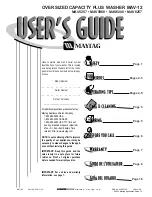
3. Make sure that there is rinse aid in the rinse
aid dispenser.
4. Load the baskets.
5. Add the detergent.
6. Set and start the correct programme for the
type of load and the degree of soil.
Loading the baskets
Refer to the supplied leaflet with examples
of the load of the baskets.
• Only use the appliance to wash items that
are dishwasher-safe.
• Do not put in the appliance items made of
wood, horn, aluminium, pewter and copper.
• Do not put in the appliance items that can
absorb water (sponges, household cloths).
• Remove remaining food from the items.
• Make soft the remaining burned food on the
items.
• Put hollow items (cups, glasses and pans)
with the opening down.
• Make sure that cutlery and dishes do not
bond together. Mix spoons with other cutlery.
• Make sure that glasses do not touch other
glasses.
• Put small items in the cutlery basket.
• Put light items in the upper basket. Make
sure that the items do not move.
• Make sure that the spray arms can move
freely before you start a programme.
Using the detergent
Caution!
Use only detergents for
dishwashers.
Do not use more than the correct quantity
of detergent. Refer to the instructions on
the detergent packaging.
1
2
A
3
Put the detergent or
the tablet in compart-
ment (
A
).
A
B
If the programme has
a prewash phase, put
a small quantity of
detergent in compart-
ment (
B
).
4
Detergent tablets do not fully dissolve with
short programmes and detergent residues
can stay on the dishes.
We recommend that you use detergent tablets
with long programmes.
Combi detergent tablets
These tablets contain detergent, rinse aid and
other added agents. Be sure that these tablets
are applicable to the water hardness in your
area. Refer to the instructions on the packaging
of the products.
22
www.zanussi.com
















































